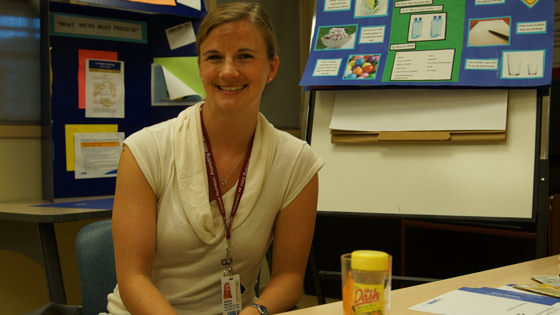 Amanda Walker, a dietitian at the Peter Munk Cardiac Centre, runs the weekly nutrition class for heart failure patients and their families. (Photo: UHN)
Amanda Walker, a dietitian at the Peter Munk Cardiac Centre, runs the weekly nutrition class for heart failure patients and their families. (Photo: UHN)
A Diet for the Heart
A team from Allied Health and Registered Dietitians at the Peter Munk Cardiac Centre recently rolled out an interactive education class for heart failure patients. Amanda Walker, a Registered Dietitian, runs the weekly class and describes this new initiative.
Did you know that one of the biggest contributors of sodium in the average North American diet is bread? Bread might not taste salty and it doesn't contain a huge amount of sodium, but if you eat it every day it can add up quickly.
Following a low-sodium diet is much more than not adding salt to your food. For some patients – especially those suffering from heart failure – following a low-sodium diet is critical.
The skinny on sodium
Eliminating all sodium from your diet is impossible, which is fine because sodium is an essential nutrient that our bodies need in small amounts. Too much sodium, however, can lead to high blood pressure and is a significant risk factor for heart and kidney disease.
Most Canadians consume more than double the daily recommended amount of sodium in their diets – likely due to lack of awareness of the hidden sources of sodium.
Educating patients
We introduced a weekly class, called 'Nutrition and Heart Failure,' to provide information in a more effective manner and improve patient learning. We've found it more efficient to teach the class to three or four patients at a time, as opposed to visiting each room individually.
In the class we review why it's important to limit sodium, identify common high-sodium foods and discuss lower sodium options. Finally, participants learn how to read food labels in order to identify low-sodium choices when grocery shopping.
Sodium and heart failure
Sodium intake leads to increased fluid retention in the body, which puts stress on your heart. In a heart failure patient, that scenario could literally prove fatal.
Swollen ankles, reduced appetite and shortness of breath are other symptoms of too much sodium intake by a heart failure patient.
Tips for reducing sodium in your diet
Health Canada recommends daily sodium intake of 1,500–2,300 mg. That range is sometimes lower for heart failure patients.
Amanda's 3 tips on limiting sodium intake:
-
Be aware of the 'high-sodium hit list'
Avoid: Processed meats and cheeses, canned soups, canned vegetables, sauces, dressings, chips, instant noodles, pickled, smoked and cured foods.
Aim: Foods with less than 100 mg of sodium per serving
Alternatives: Fresh vegetables, sodium-reduced or unsalted versions of snacks, deli meats, etc.
-
Limit adding salt to your food
At first, your food might taste bland, but your taste buds will adjust, usually within 6-8 weeks.
Avoid: Table, kosher, sea and other types of salt
Aim: Add flavour without adding salt.
Alternatives: Herbs, spices, garlic and lemon enhance taste without increasing sodium content.
-
Eating at a restaurant? Watch out for hidden sodium
Avoid: Fast food or restaurant-eating on a regular basis. Breaded, battered, fried foods, sauces, gravy and condiments are sodium rich.
Aim: Smaller portion sizes.
Alternatives: Sauces, salad dressings, condiments on the side.
-
Always read food labels
Look for the word 'sodium' on nutrition information provided on a food product and check the serving size listed. When comparing two products, ensure the serving sizes are the same. You may have to do some math to ensure an accurate comparison.
Learning is a two-way street
I am amazed by the participants' thoughtful questions and encouraged by the advice shared between patients and family members within a group setting. Some patients have been on a low- sodium diet for many years and attend the class as a refresher. They bring knowledge regarding specific low-sodium products and brands, and other great tips to share!
Our team is there to educate the patients, but we learn something new from our students each class!
Overall the program has been a great success. It allows patients to return home confident that they can follow a low-sodium diet outside the hospital.
